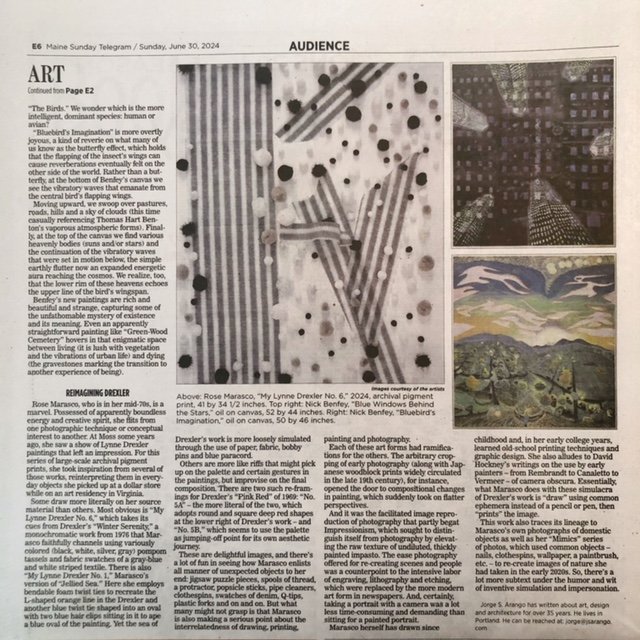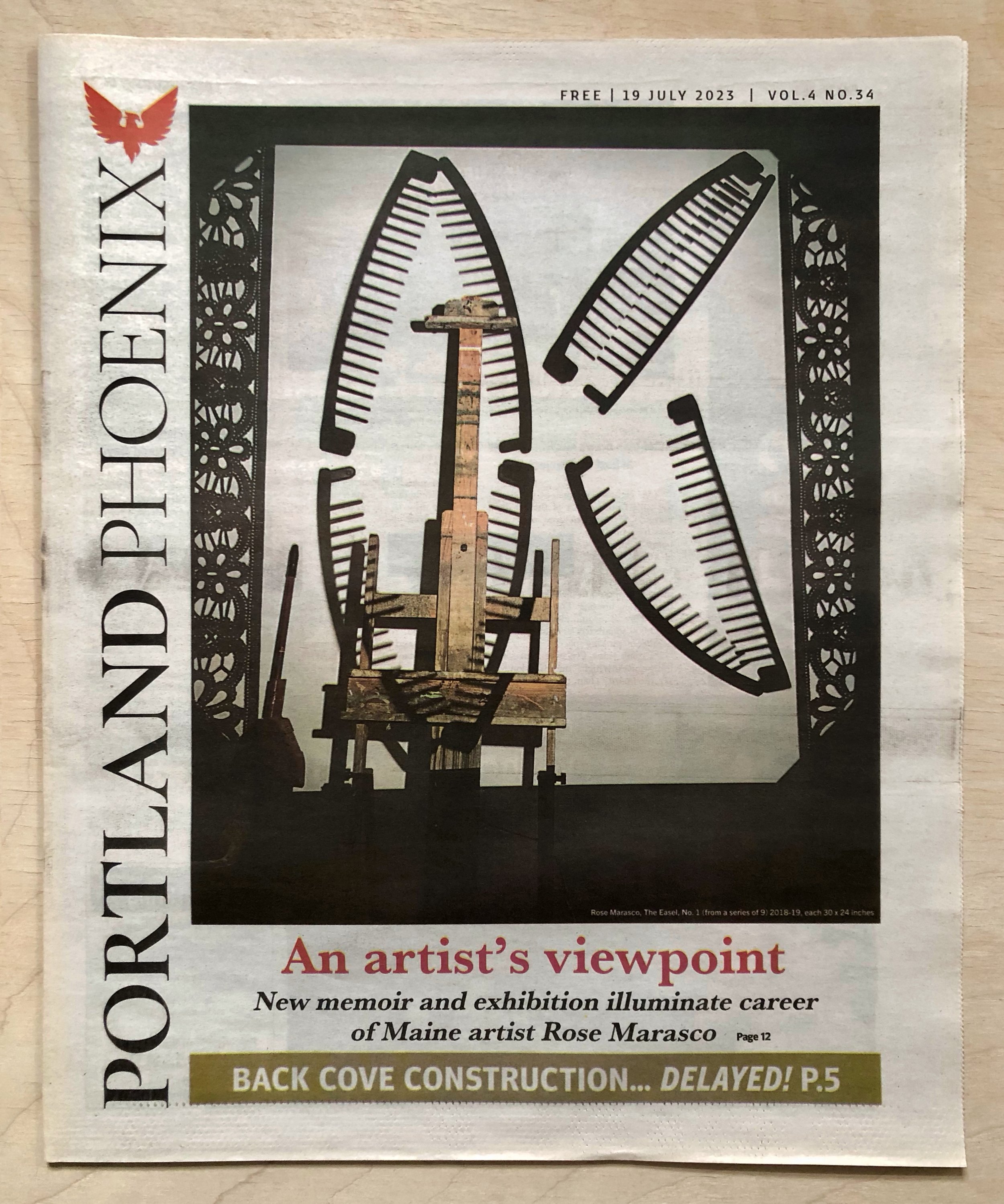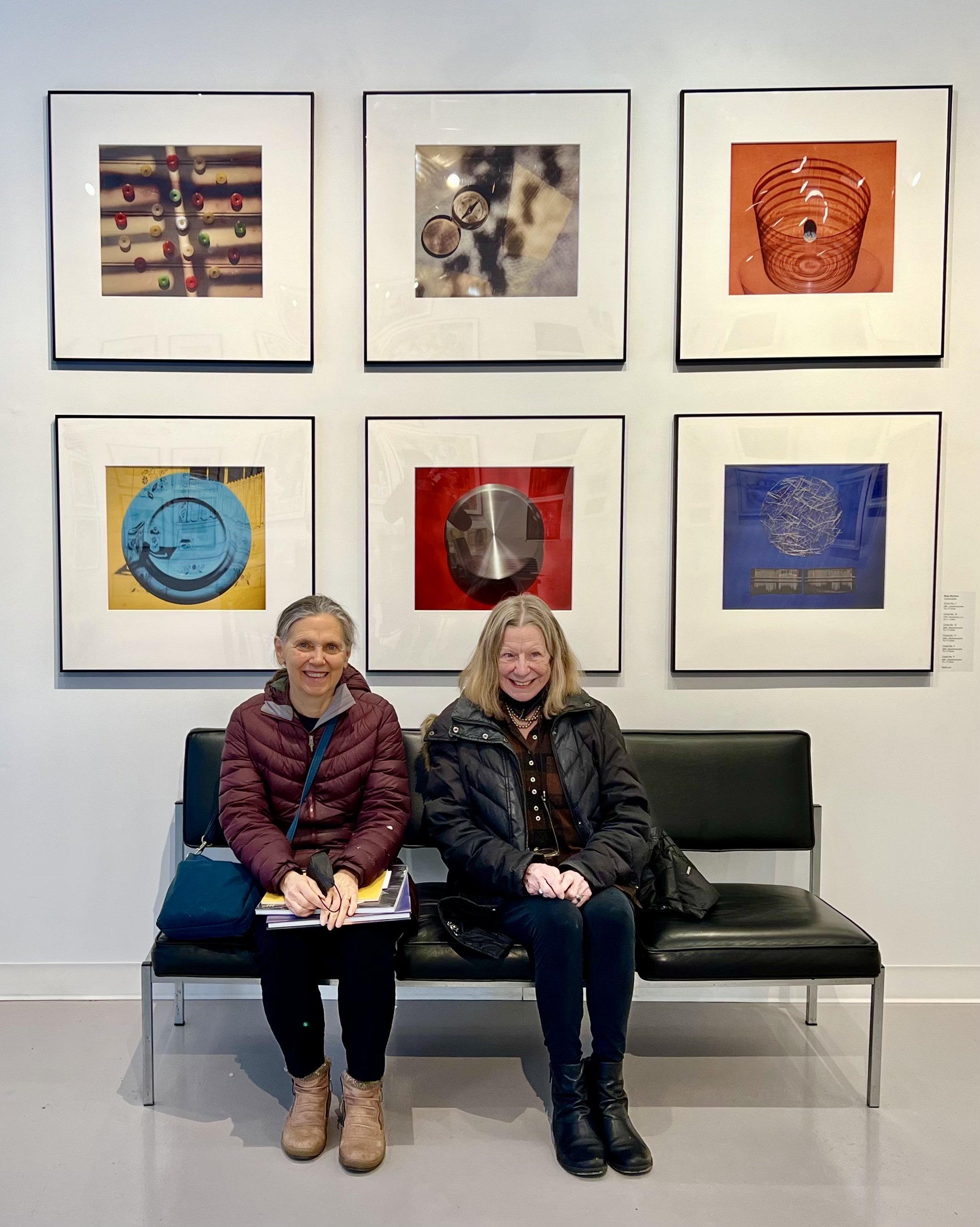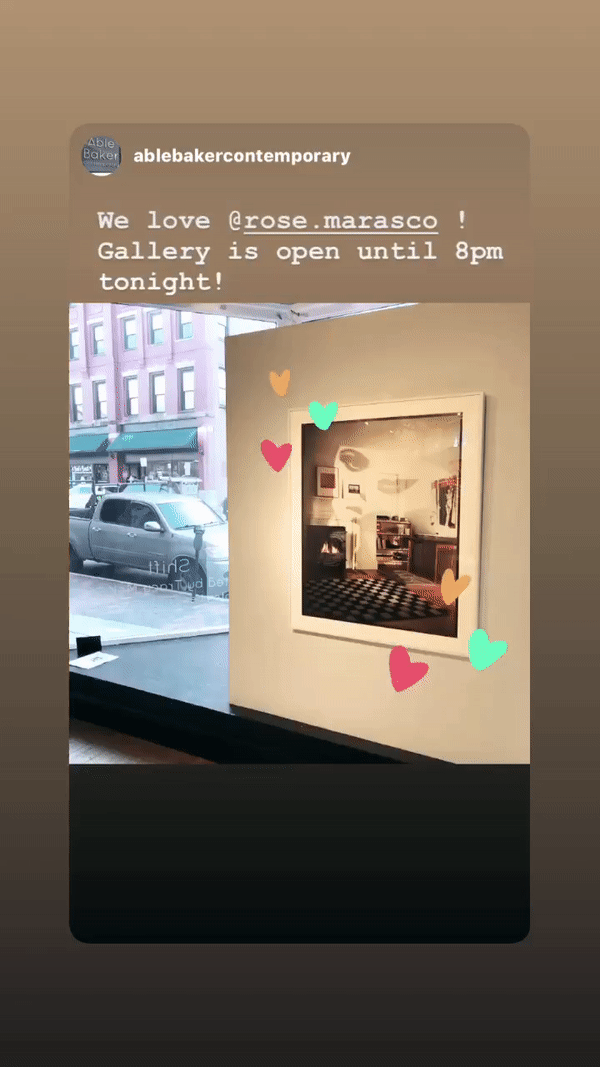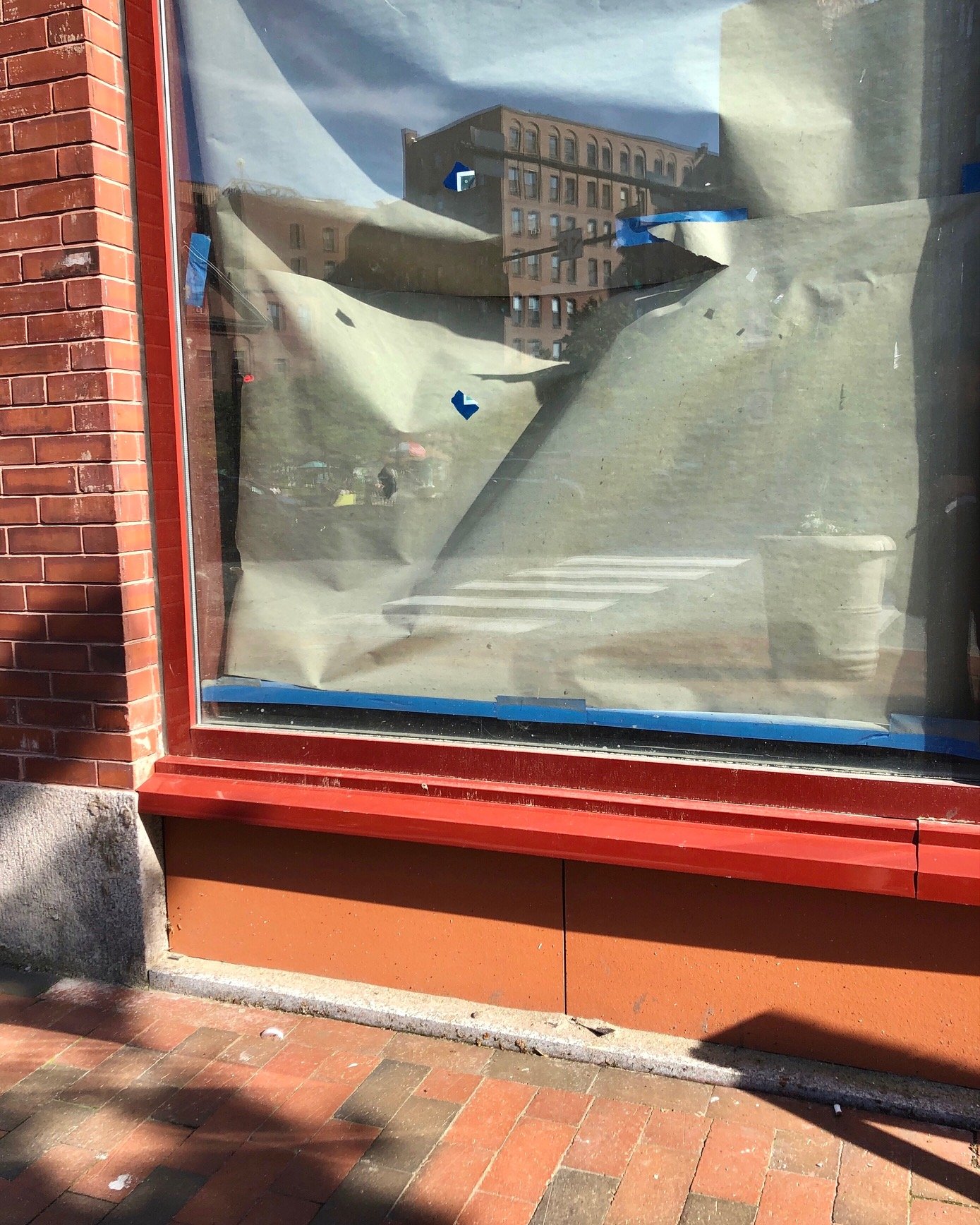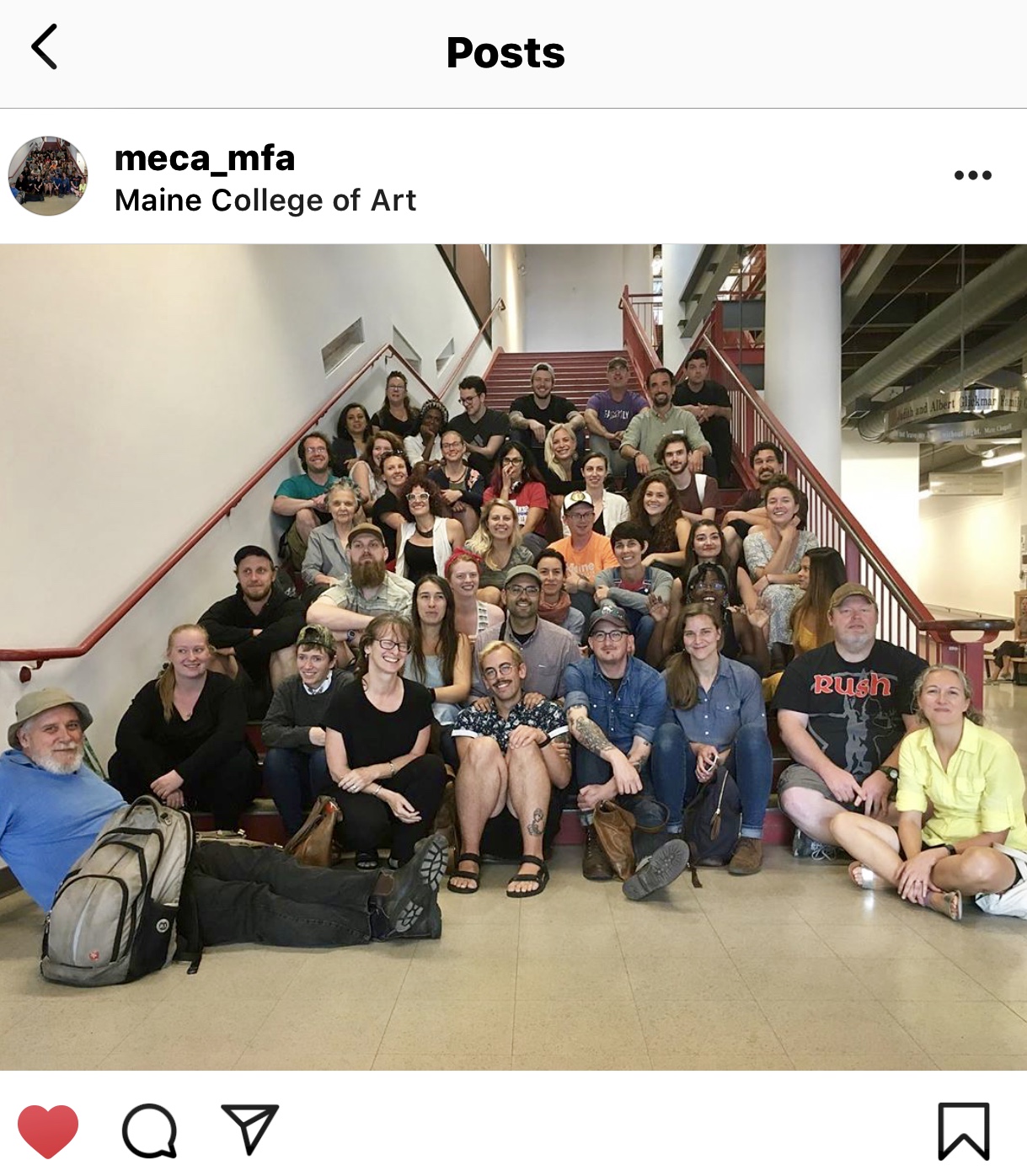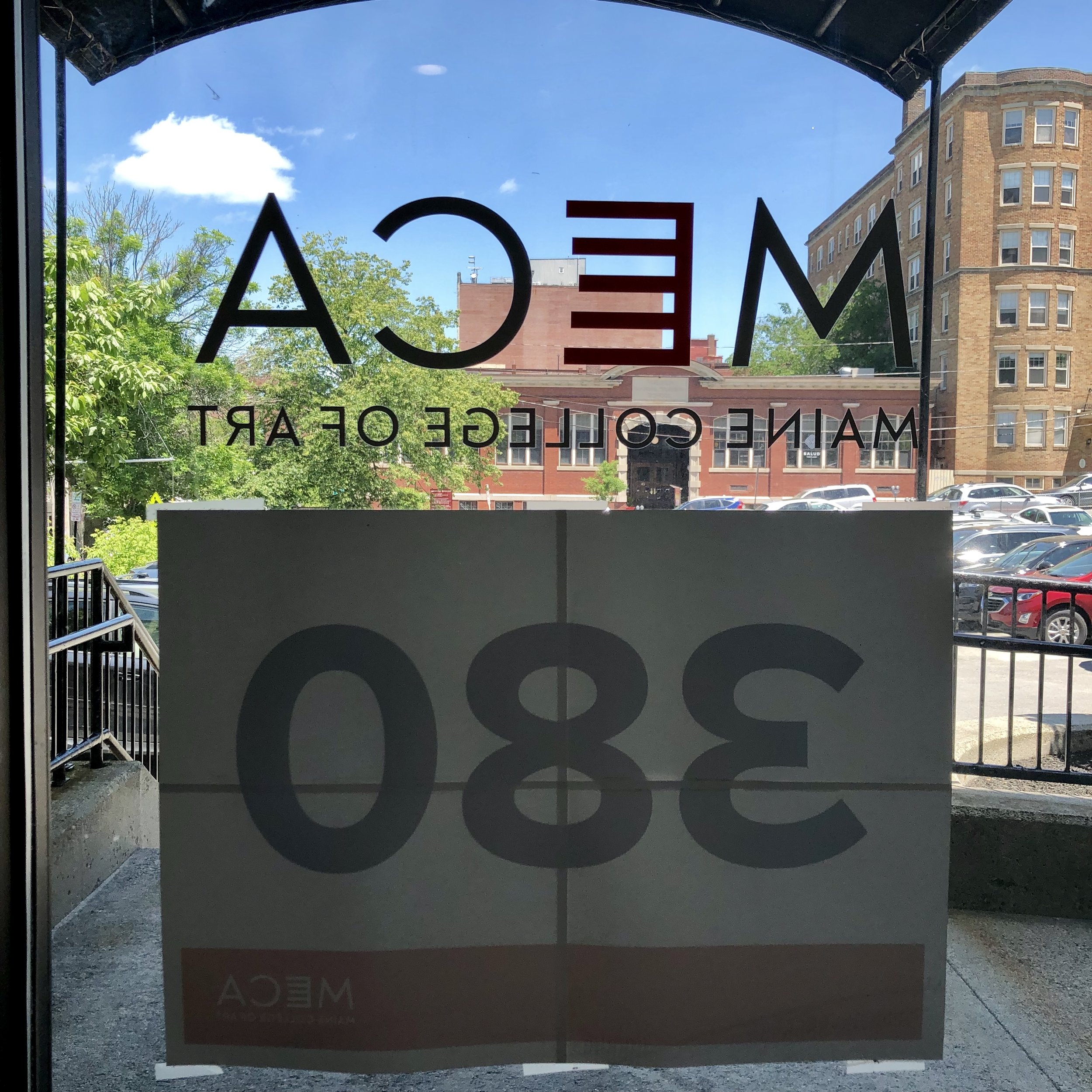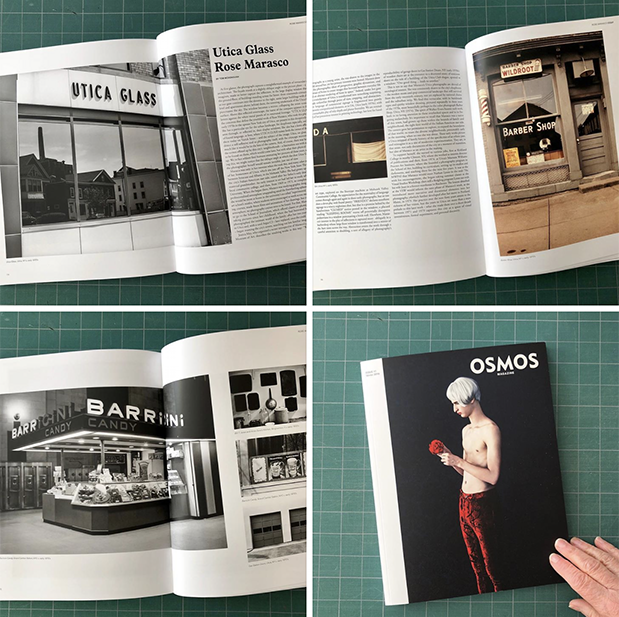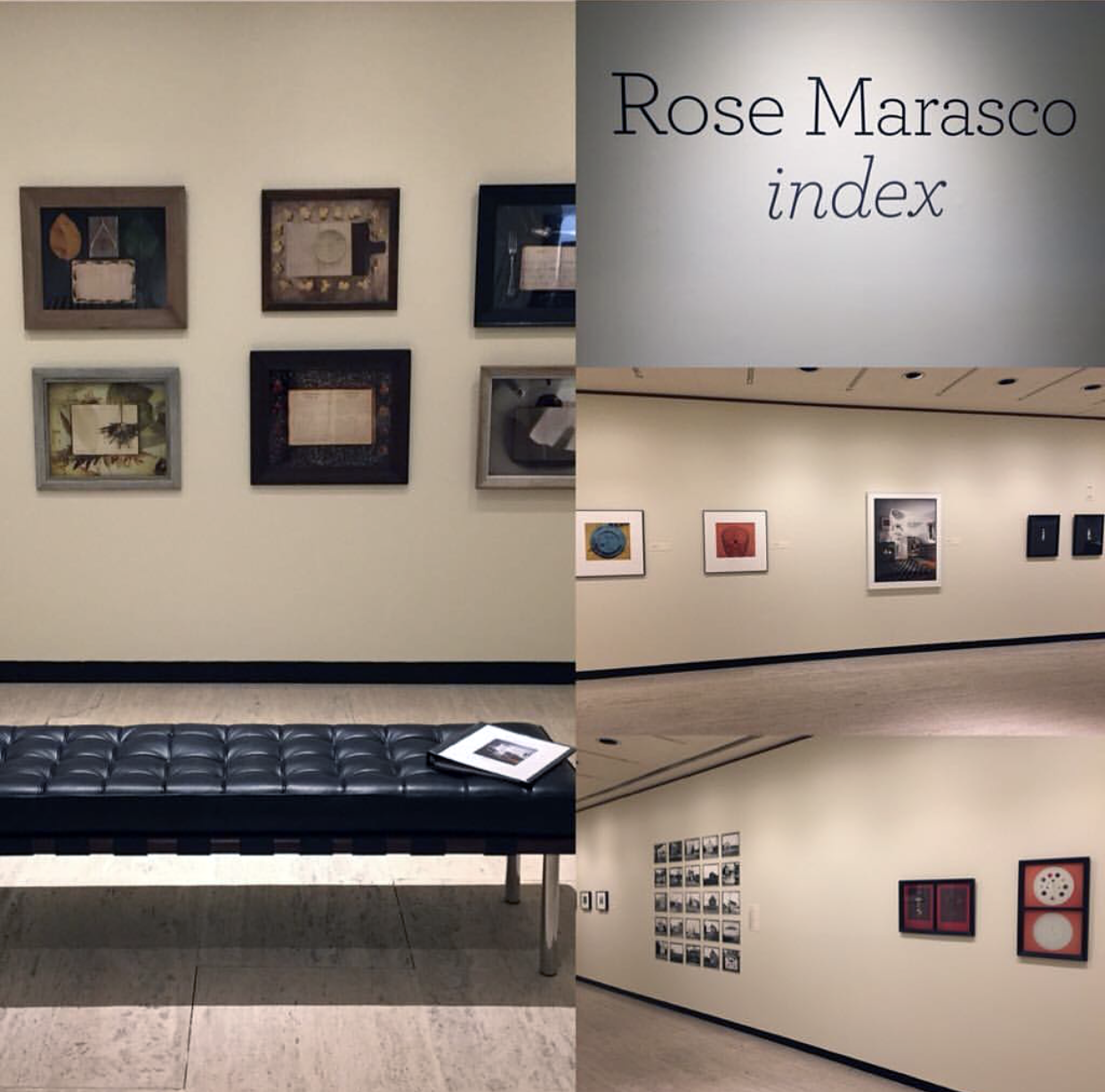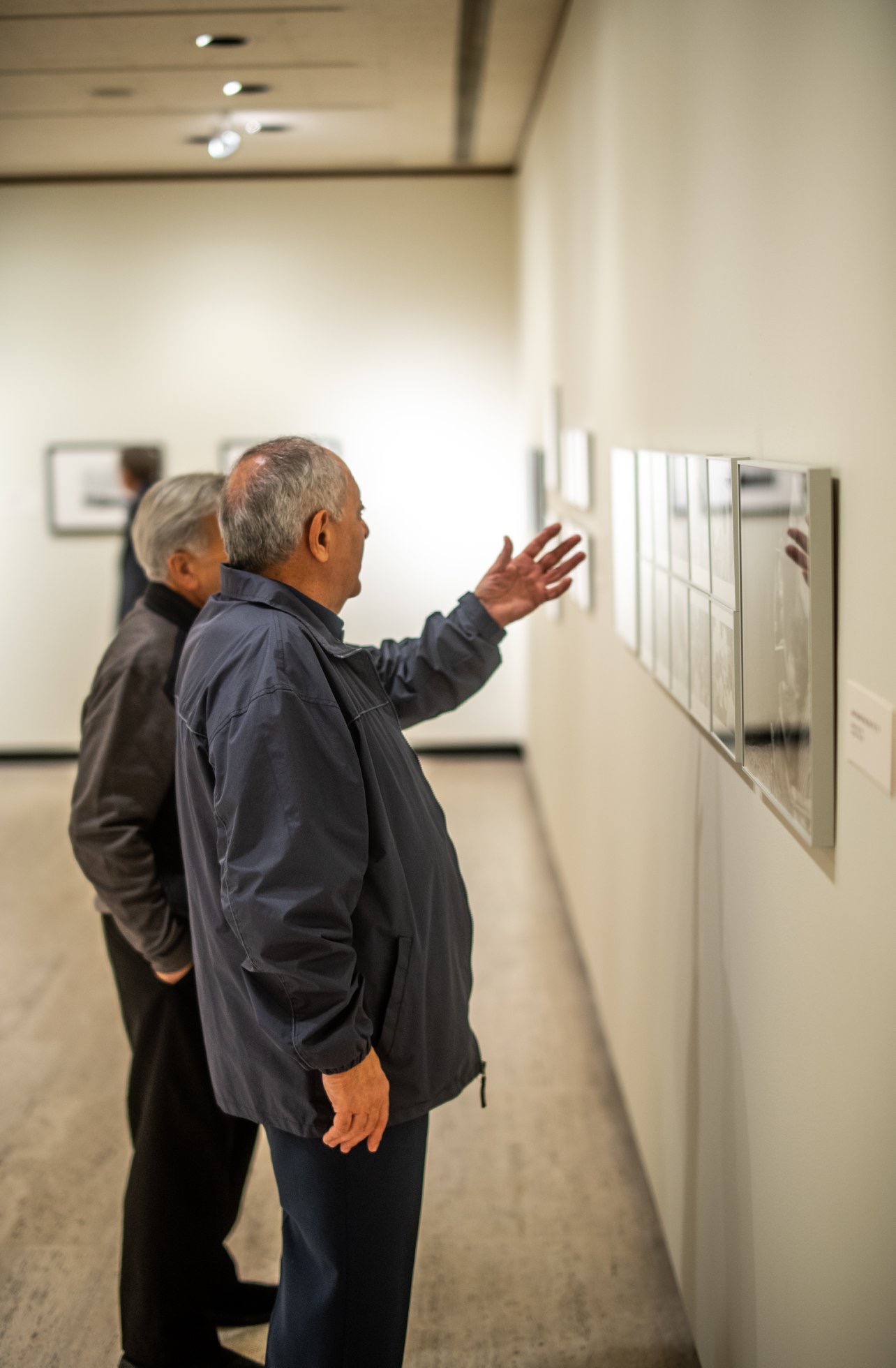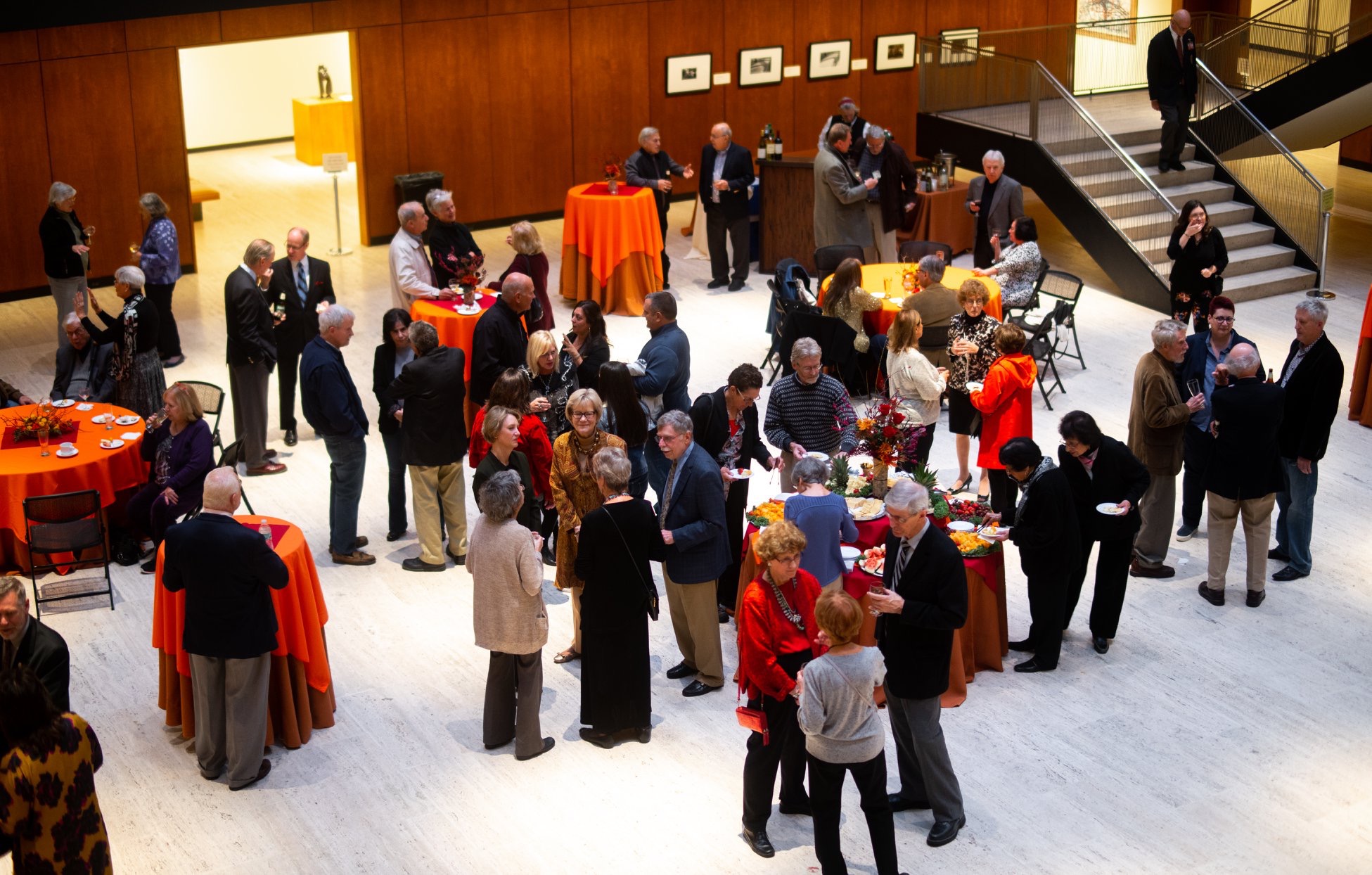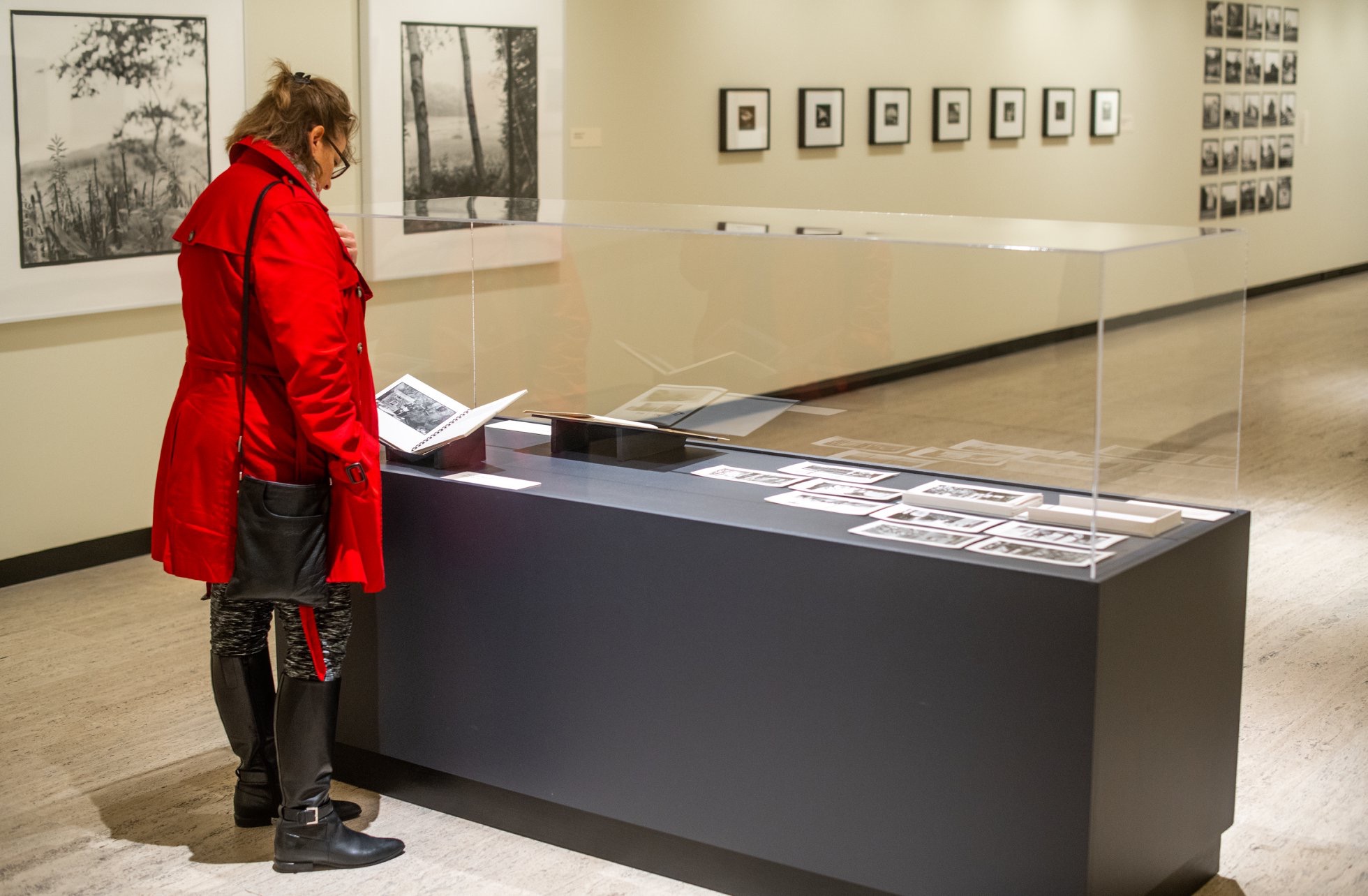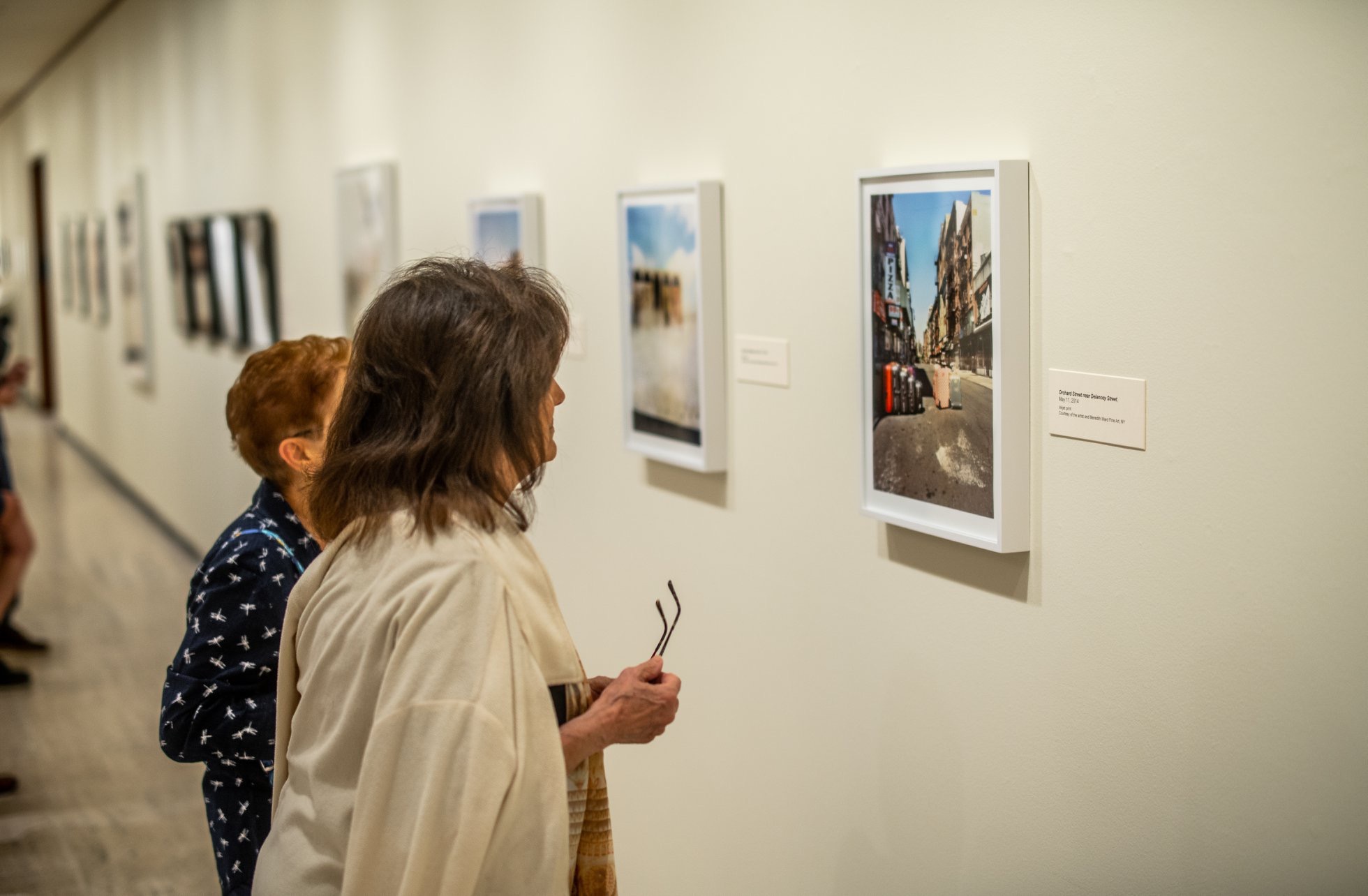Exhibition review of my solo exhibition at the Portland Museum of Art. Published in Hyperallergic on August 30, 2015
Printed Matter, Book Fair, 2024
My book “ At Home” featured & book signing at OSMOS booth at Printed Matter, 2024 NYC book fair
One of my first exhibitions, 1976 - with Marion Faller & Sylvia deSwann

One of my first exhibitions at Kirkland (NY) Art Center, 1976— with Marion Faller & Sylvia De Swann (Ames).
Read MoreMy Lynne Drexlers, 2024
Jorge Arango -review of my 2024 exhibit at Moss Gallery of my re-created photographs of Lynne Drexler paintings.
Camera Lucida, my solo exhibition, was held at the University of New England Art Gallery, ( June 23-Oct.8, 2023) in Portland, Maine. The exhibit was curated by Hilary Irons, Director of the Gallery. I have a long history of experimentation in my work. I particularly enjoy—making something to be photographed. The exhibit displayed a sampling of my photographs from the UNE Photography Collection, and the Maine Women Writers Center at UNE collection. The majority of the photographs on display are from recent projects and were never before exhibited.
Portland Phoenix, An Artist’s Viewpoint by Edgar Allen Beem, Cover image & expanded review. July 2023 Vol.4 No.34
Maine Museum of Photographic Arts features works of 24 artists in 'Twelfth Night.'
Thanks to Denise Froehlich, director of the Maine Museum of Photographic Arts (MMPA), for including me in the exhibition, 'Twelfth Night.’ A friend made this photo and sent it my way, happy to see folks enjoying the work. Jorge S. Arango from the Portland Press Herald wrote a review of the exhibit you can read here.
Art review: Portland photo museum puts on another jam-packed show
“My Circle series 2001-2002 (no.’s 1-15), completed my 10 year —Domestic Objects project. It seemed the perfect ending. This series also began my use of projected imagery. I had previously experimented with projections a bit in both my Silhouette and Blueprints series. These continued to evolve into my full-scale use of this strategy in my Projections series. I have continued to use projected imagery in my practice for 20 years. With the Circles, I used sunlight as a light source and created or altered shapes that would fall onto my arrangement of objects. I use both analogue & digital projectors to make my photographs.
Rose Marasco & Claire Seidl at Maine Museum of Photographic Arts
August 26th 2022 thru October 8, 2022. A gallery talk with the artists was held September 8th 2022, 5-8 pm
Video Interview: Lights Out Gallery, Spring 2022 " The Mirror With A Memory "
Lights Out is a creative agency based in Norway, Maine . They focus on the central question of why folks create and seek to illuminate the world to how and why artists create their work.
John Yau, studio visit article for Hyperallergic
Honored to have a second review from the always perceptive John Yau. Read it on Hyperallergic here.
SHIFT - Review of Exhibit at Able Baker Contemporary
I was recently included in an ambitious exhibition entitled, SHIFT. The exhibition, curated by Tracy McKenna was at Able Baker Contemporary, Portland, Maine. The review appeared on Nov.21, 2019 and was written by Julien Langevin for ART SPIEL.
Plastic Expressions in Particularity: Nature Moves in Tracy McKenna’s Shift at Able Baker Contemporary (Excerpt)
There’s a level of darkness to Shift. This collection of work speaks to identity, politics and natural environment in a way that begs the viewer to insert their own perception, their own reality into the mix. Rose Marasco’s photograph Projection No. 5 (2007) literally layers conflicting perceptions on top of one another. A feminine face is projected over the view of an interior, lips coated in a deeply colored lipstick stretch to the left of a Cindy Sherman poster hanging on the wall. A warm fire exists in a fireplace while the room is unoccupied except for the large face obscuring the wall. The scene is inviting yet exclusionary. The viewer could be standing alone in the room, yet not totally alone, as a single blown-up eye meets their gaze. The piece questions identity and existence, perception and occupation. Are we ever really alone if we are looking upon something that gazes back at us?
The Cafe Review - 30th Anniversary Issue
I am most pleased to be included in this historic issue of The Cafe Review. Congratulations to Steve Luttrell, the Founding & Publishing editor and his staff for this accomplishment. This 30th anniversary issue, published Fall 2019, includes the work of 51 poets, 3 reviewers, and 26 visual artists. Cover image below by Micheal Waterman, followed by my photograph.
You may purchase this issue and see more on their website: www.thecafereview.com
My photograph is from my Window Series which you may see all of on my Instagram account.
Summer 2019 Teaching in the MFA program at Maine College of Art (Meca)
Two years ago, I was a Visiting Artist in the Meca MFA program. This year, I was asked to join the faculty to teach in the summer intensive session. Intense it was ! And, interesting and informative as well. Thank you Meca for the opportunity to work with the faculty and students.
OSMOS Magazine Issue 17 – Winter 2019
Feature article by Tom McDonough with a portfolio of some of my earliest black & white photographs most made in the early 1970’s while I was still living in my hometown, Utica, NY. Thank you Tom & OSMOS Magazine.
UTICA GLASS
Tom McDonough
At first glance, the photograph captures a straightforward example of vernacular commercial architecture. The façade stands at a slightly oblique angle to the picture plane – a choice, one imagines, made to better capture the reflection, in the large display window that dominates the ground floor, of buildings standing across the Street: three nineteenth-century homes and, as our gaze continues into the distance to the right, some larger buildings with shops at street level and apartments above; behind them, the towering smokestack of the Utica Club brewery punctuates the sky. The window becomes a mirror, collapsing the street scene onto its flat surface. Above this reflected streetscape, the name of the company appears in dark uppercase letters against the white metal panels of its renovated frontage: “UTICA GLASS.” Many of the concerns that define the youthful work of Rose Marasco, who took this photograph in the early 1970s in the upstate New York city of Utica, are present in this deceptively modest image. She has a particular eye for the urban landscape, for shopfronts especially, and what could be seen through, or reflected in, their display windows. She also has a keen affinity for the play of found language, as here, where UTICA GLASS names both the owner of the property – still there today on Varick Street – and the subject of the image: Utica, on glass. One might also detect a self-reflexive nod to photography itself, with the cityscape mirrored in the window much like it would be in the lens of the camera. And, of course, there was her fascination with the scenes offered up by this city above all, captured as she wandered the streets of its neighborhoods – a fascination not with so much the people to be found on them, which would come later, but with what their physical appearance offered up. We in fact seldom find humans animating her pictures of these years, and when considering this, we might notice that the oblique angle at which she shot Utica Glassguarantees that the photographer herself would remain invisible, just out of view.
Marasco was only in her twenties when she took this, and many other striking photographs, of her hometown of Utica, which sits just off the New York State Thruway about halfway between Syracuse and Albany, in the Mohawk Valley. She had grown up there, in the heart of the city’s Italian-American east side, raised after her father’s early death by her mother and maternal grandmother. An early interest in art had led her to study advertising design at the local community college, and then, from 1969 to 1971, to complete her BFA at Syracuse. When she began there, Marasco was studying graphic design but quickly found its professionalized atmosphere unappealing amid the freewheeling upheavals of the late ‘60s; she would be more at home in the university’s so-called “experimental studios,” a home for the art school’s misfits, where students were encouraged to work across media. She took printmaking courses, made 8mm films and animations of her drawings, but even amid this permissive atmosphere, no photography courses were to be found. For that, Marasco had to get permission to go to the School of Journalism, which offered classes on photojournalism. She had been taking pictures since her childhood, when she had borrowed her parents’ Brownie and photographed the intimate world of the family; after her two years at Syracuse, she returned to Utica and, with a used Argus C3 – later replaced, once she could afford it, with a Nikkormat – began roaming the city’s streets, searching out less familiar images.
Jessica May, who organized a recent retrospective of Marasco’s photography at the Portland Museum of Art, describes the resulting works in this way: “When she turned to making photographs as a young artist, she was drawn to the images in the world around her, yet her primary interests were formal: Marasco drew on the photographic ideas of perspective, graphic dynamism, and contrast of forms to create images that hovered between everyday life and an abstract rendering of form in space.” Indeed, under her gaze the everydayness of Utica is transformed into something surprising, made unfamiliar through point of view, cropping, and abstraction. The language of commercial signage is fragmented into purely phonetic-compositional elements, as in DA, Utica(early 1970s), with its remarkable play of inky depth and planar frontality. We are reminded of her precocious interest in printing technology, her love for handset type, explored on the linotype machine at Mohawk Valley Community College. An appreciation for the materiality of language comes through again and again in these early photographs, but so too does a clever play with found poetry: “FRIENDLY,” declares storefront signage in a wintry nighttime shot, but that is a promise belied by the handwritten “CLOSED” notice posted in the window; a placard reading “SLEEPING ROOMS” warns off potentially disruptive pedestrians in a window punctuating a brick wall. Elsewhere, the play of reflections captures Marasco’s interest, like in Utica Glassor another obliquely shot storefront, a barbershop whose large front window is transformed into a mirror of the bare trees across the way. And abstraction enters the work through a careful attention to doubling, a sort of allegory of photography’s reproducibility: of garage doors in Gas Station Doors, NY(early 1970s); of wooden chairs set at the entrance to a shuttered store; of restroom doors on the side of a building; of the Utica Club slogan, spotted in a window: “One good thing ... leads to another.”
This is not to say that Marasco’s Utica photographs are devoid of sociological interest. She was consistently drawn to the city’s shopfronts – the modest mom-and-pop commercial landscape that still survived from the early twentieth century, not yet replaced by national chains and the suburban strip. We find this vernacular, with its handmade signs and quirky window dressing, pictured repeatedly in these years of the 1970s, most beautifully perhaps in the color photograph Barber Shop, Utica, NY(1974). The spirit of Walker Evans haunts such work, both in its loving attention to these overlooked spaces and in its lingering melancholy. It’s important to recall that Marasco was a native of this town, had grown up there within the bounds of family and neighborhood, the tight-knit world of the Italian-American east side. The camera gave her permission to explore, to expand the boundaries of that world, to roam the diverse neighborhoods, presumably early in the morning, when no one else was about. These early works picture a Utica stripped of family history, of the specificities of an ethnic past, and reimagine it as a site of modernist experimentation. They are, in that sense, not only documents of the city at a moment of transition, but also of Marasco as an artist in the making.
To support herself, she turned to various jobs, first at Kirkland College in nearby Clinton, NY, where she worked as interim director of publications and then, from 1974, at Utica’s Munson Williams Proctor Art Institute, where she founded a photography program in the School of Art, building its curriculum, setting up its studios and darkrooms, and teaching there for the next five years. It was at the MWPAI that Marasco would meet Nathan Lyons in the mid-‘70s; with his encouragement, she began taking summer classes at the Visual Studies Workshop, then still a fledgling program Lyons ran with his wife Joan in a former warehouse in Rochester. The lessons absorbed at the VSW would inform the next phase of Marasco’s work, as she introduced more narrative and durational elements into her photography, something already hinted at in the triptych Woman with Scarf, Rome, Italy(1976) and further developed after her move to Portland, Maine, in 1979. Her practice over the next forty years attests to the richness of her vision, but the years in Utica are more than a mere prelude to this later work – what she made there over a short decade between 1971 and 1979 captures this city as a space of visual inventiveness, formal experiment, and personal discovery.
Munson Williams Proctor Arts Institute - "index" exhibition
My retrospective exhibit index which originated at the Portland Museum of Art, Maine opened at MWPAI on Oct. 13th, 2018 and continues thru January 6, 2019.
Virginia Center for the Creative Arts -VCCA
I spent the month of February and a few days into March, 2018 in residency at VCCA. I had an incredibly productive time and met many dedicated and hard working visual artists, writers, and composers. It's a solid and welcoming place and I highly recommend—beautiful grounds, lots of space to roam, great studios, and all meals provided.
I continued the direction that began for me in Finland. And then things got even more active for me. Here's a sneak peek from one of the projects I made at VCCA. Title of this piece is Easel and it is a series of nine photographs. My framing and the easel, broom, and dustpan stay the same, while the imagery I project, is different in each photograph.
Easel no.3, 2018-19
Arteles Creative Center, Finland
I was awarded an international artist residency at Arteles Creative Center for the month of October 2017. I produced a whole new body of work, related to my interests but with much experimentation and growth too. Here’s the iPhone self portrait with the group shot which I made for us.
Visiting Artist, Maine College of Art MFA program 2017
In July 2017, I spent a week as a Visiting Artist with the MFA students at MECA. I was very impressed with the level of work being produced by the students. And it was a pleasure to work with their dedicated faculty. They treated me extremely well too !
I prepared a new lecture for the Monday evening presentation, which was also open to the public, and we had an overflow crowd.
Studio Moments ... arranging pieces of found glass on the scanner.
Rose Marasco in her own words
This article was originally published by the Portland Museum of Art Blog on April 28, 2015 and was written by Jessica May. In this touching episode of The Backstory, photographer Rose Marasco narrates the moments that brought her to Utica, New York in 1988 to photograph the Saint Rosalie Feast—and how that project affected her life and photographic career.
Over the past forty years, Rose Marasco has built a photographic career that offers an extraordinary narrative about the transformative power of art. Rose Marasco: index brings that career together at the Portland Museum of Art in the artist's first-ever retrospective.
The exhibition highlights the vitality, dynamism, and overall spirit of American photography in the post-war period, when artists were turning away from the idea that a single print was the summation of artistic excellence, and instead thinking about how photographs could tell stories—how they could move us, make us think, and appeal to our ideas of what the world could be, as well as what it is.
Marasco is not only one of the finest narrative photographers in the country and beloved artists in Maine, but also an eloquent storyteller in her own right. In preparation for Rose Marasco: index, I sat down with Rose as she walked us through the milestones of her life's work. In this poignant and touching excerpt from those interviews (which became the catalogue Rose Marasco: index, available here), Rose reflects on her Catholic roots and upbringing in Utica, New York, and how the knowledge of oneself as an artist is inextricably tied to the past, as well as one's work.
Japan in Maine, and NYC too.
In the Fall of 2016, during the middle of my exhibition index, at the Portland Museum of Art (PMA), I decided it would be a good idea to go to Japan, a place I have always wanted to visit. I normally do not go away and photograph but I thought I might try making some photographs of nature while there.
This came out of seeing my own 1987 Gilsland Farm photos on exhibit at the PMA — large square medium format mural photographs (see last 4 photos in Maine). I brought my Rolleiflex camera and size 120, both color and black & white film. I also shot with my iphone and a plastic 35 mm camera for fun. Upon return, as I suspected, I liked the black & white medium format results the best. I developed the film at home and cleaned up my make-shift basement darkroom enough to make contact sheets and small work prints.
Kyoto Japan, 2015
The darkroom! I had forgotten how much fun it truly is; and how physically engaging it felt to work in this familiar manner. Not since the early 1990's in making the 4x5 inch Maine Grange exteriors and later, in the detail composites of the interiors (see Maine Grange) have I seriously shot in black & white.
In assessing the Japan photographs, I thought — well, ok nature, I’m in Maine . I think I'll go for a walk !
Georgetown, Maine, 2016
I am continuing to explore my adopted home state of Maine and I am totally enjoying the process. I also continue to work on the NYC pinhole photographs, color negative 4x5 inch film, filling in the areas I have not covered geographically and reassessing what I need to do to finish this project.










